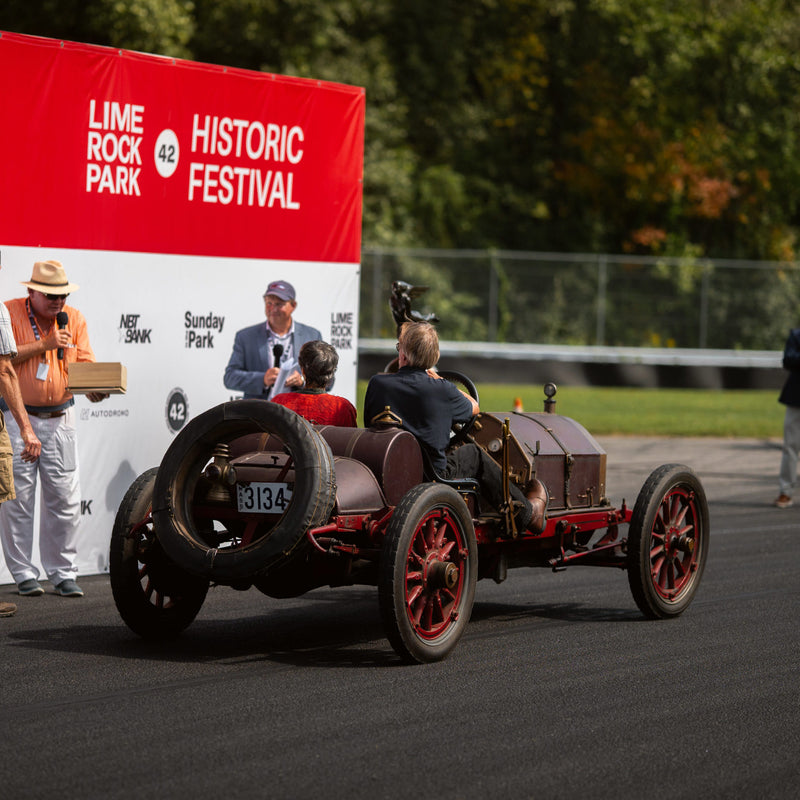We both climb into what can only be described as a tight, aluminum sausage, and the instructions I had just received suddenly make complete sense. There is literally no place for my arms, so they naturally find their positions exactly where I was instructed to place them.



It’s the first day of Journées d’Automne 2013 rally (Days of Autumn) organized with the help of Veuve Clicquot and Chapal, and the car, a 1927 Bugatti Type 35B, wears the its signature French blue with a glorious patina. Powering this 750kg Grand Prix racer is a tiny 2.3-liter 8-cylinder engine putting out somewhere around 140 HP with the help of its supercharger. There are no seatbelts or roll-bars. A helmet and my ability to keep myself inside the car are the only safety devices available.
Frédéric starts the engine. It is loud and thrilling, and it sounds as if it’s begging you to step on it, telling you it would rather not sit around. Frédéric enters the track and we take our first couple of corners at a mild pace. Already I realize being passenger is anything but a passive experience. My arms and my core are working hard to keep me inside the car. As the pace picks up and he starts drifting into and out of turns, I become ever more aware of my mortality.
In our first lap, Frédéric easily passes a few cars from much later decades, but with the second lap, he really puts his foot into it, and I think to myself “Holy ****! That was just a warm-up lap?” Now we’re spending more time going sideways than forward. With each corner Frédéric charges in faster and brakes much later, getting the Bugatti sideways as he powers out of the turn. We approach the outer edge of the track at speed, and each time my inner voice says, “This is it; we’re going off track. Those skinny tires are going to dig into the moist grass, and we’re going to flip. Your helmet will keep your skull from cracking, but it won’t help one bit in keeping your neck from snapping.” And yet, without failure, with each corner exit Frédéric uses every millimeter of the track with supernatural precision, taking the Bugatti to the very edge without ever dropping a wheel on the grass.



I had never met Frédéric before. I knew nothing of his driving ability or of his desire for self-preservation. The first few laps were positively mortifying. By about the third or fourth lap, it was pretty clear that Frédéric is a very competent racer and knows this particular Bugatti extremely well. My fear reluctantly gave way to trust, in the same way you come to terms with a roller coaster, which is to say you know intellectually nothing is going to go wrong, but you’re scared to death anyway.
After several exciting laps in which Frédéric passes car after car in this friendly track event, the session comes to an end. I crawl out, feeling like I had just spent an hour doing an intense upper body workout. Later I learn that Mr. Frédéric Novo is not only an excellent driver but is also one of France’s most renowned Bugatti experts. In fact, all the Bugattis present today belong to Frédéric’s clients.
I must admit that before this day, I had never been a big fan of pre-war cars. Sure, I love the looks of a BMW 328 Mille Miglia or an Alfa Romeo 8C of that period, but I never imagined that the drive would excite me. How wrong I was! Everything we love about sports cars from the ‘60s or ‘70s is amplified several times in a pre-war sports car – the connection with the road, the smells, the sounds, the materials. The experience is raw and pure. Even as a casual observer, the mere presence of these Bugattis is unrivaled. Seeing and hearing an entire row of blue Bugattis winding through the autumn country roads in Champagne is a hair-raising experience.
I am addicted! I now find myself lusting after a Bugatti, preferably with the patina of proper use and maybe even some paint flaking off here and there. I want the rush of sliding it on the track. I want a pair of leather goggles and a leather helmet and the wind and rain hitting my face as I drive the Bugatti through the damp countryside. Thanks Frédéric! As they say, the first one is always free.








Click the following links to read more of our coverage of the weekend:Autumn Drives in France Involve Castles and Tracks ,How to Crash a Vintage Car Rally and Get Away with It , andEvent Inspiration: Champagne Wishes and Leather-made Dreams .
Photography by Jonny Shears, Kika Vigo-Behnia, and Afshin Behnia for Petrolicious




















































